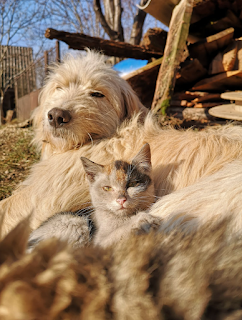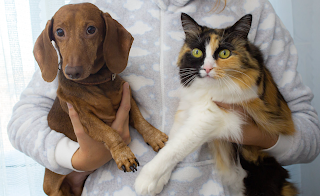Exploring the Biological Barriers
 |
| Can a dog mate with a cat? Photo by Nadia Vasil’eva from Pexels |
If you find yourself with both feline and canine companions, the question may have crossed your mind: Can a dog mate with a cat? The answer, in simple terms, is no. Cats and dogs are distinct species with significant biological differences that prevent successful mating and reproduction. Let’s delve into the reasons behind this impossibility.
1. Genetic Incompatibility: The Foundation of Reproduction
“Cats and dogs cannot mate” is a definitive statement grounded in the fundamental dissimilarity of their DNA. Unlike hybrid species like ligers and mules, where sufficient DNA similarity allows for offspring, cats, and dogs lack the genetic common ground required for successful mating. The absence of complementary DNA sequences and base pair similarities renders reproduction between these species unattainable.
2. Chromosomal Disparity: Counting the Differences
DNA, housed within chromosomes, plays a pivotal role in determining reproductive compatibility. Cats possess 38 chromosomes organized into 19 pairs, while dogs boast 78 chromosomes arranged into 39 pairs. Unlike closely related species such as lions and tigers, where chromosome pairs align, cats and dogs display a significant chromosomal gap. This mismatch in chromosome numbers further solidifies the biological barriers preventing viable offspring.
3. Mating Signals and Behaviors: Lost in Translation
Beyond genetics, the mating behaviors and signals of cats and dogs are as distinct as their respective species. Female dogs and cats exhibit heat cycles at different times, making synchronization for mating impossible. Additionally, the communication divide between these animals hinders any interest in cross-species mating. Dogs and cats don’t recognize each other’s mating cues, and their reproductive organs are incompatible, with a dog’s sperm incapable of fertilizing a cat’s egg and vice versa.
4. Dietary Disparities: Fueling the Divide
Dietary requirements provide another layer of separation. Cats are obligate carnivores, relying on meat for survival, while dogs are omnivores with a broader dietary spectrum. The different digestive tracts and nutritional needs create a chasm that further precludes the possibility of producing offspring between these two species.
5. Acceptance of Offspring: A Touch of Unlikely Harmony
 |
| Can a Dog Mate with a Cat Photo by Ioan-Dan Plesa from Pexels |
While biological constraints prevent the creation of hybrid offspring, there are heartwarming instances of cats and dogs accepting each other’s young. Motherly instincts can lead female dogs to care for abandoned kittens and vice versa. Although the milk composition may not perfectly match the natural mother’s, the nutritional overlap allows for the survival and well-being of the adopted offspring.
Conclusion: Navigating the Boundaries
In conclusion, the question “Can a dog mate with a cat?” finds its answer in the intricacies of biology. The genetic, chromosomal, behavioral, and dietary disparities between cats and dogs form an insurmountable barrier to successful mating and reproduction. While they may not be able to produce a hybrid species, the capacity of cats and dogs to accept and nurture each other’s offspring reflects the remarkable adaptability and compassion within the animal kingdom.
Q & A
Q: Can cats and dogs form close bonds despite their biological differences?
• A: Yes, cats and dogs can develop strong bonds based on their individual personalities, socialization, and the environment they share.
Q: Is it safe for a dog to consume cat food or vice versa?
• A: While an occasional nibble may not harm them, it’s best to avoid regular cross-species feeding due to differences in nutritional needs. Cat food is specially formulated for feline requirements, and dog food for canine needs.
Q: How do cats and dogs communicate differently, and does it affect their interactions?
• A: Cats and dogs communicate through body language, vocalizations, and scents. Their unique communication styles may lead to misunderstandings, but with time and positive reinforcement, they can learn to understand each other.
Q: Can hybrid species be created between closely related animals, similar to ligers or mules?
• A: Yes, hybrid species can be produced when closely related animals, such as lions and tigers, mate. The key factor is a sufficient genetic similarity that allows for successful reproduction.
Q: Are there instances where cats and dogs adopt each other’s offspring in the wild?
• A: While uncommon in the wild, there are documented cases of cross-species adoption among domesticated cats and dogs. Motherly instincts can lead them to care for abandoned or orphaned kittens or puppies, demonstrating a remarkable aspect of animal behavior.
